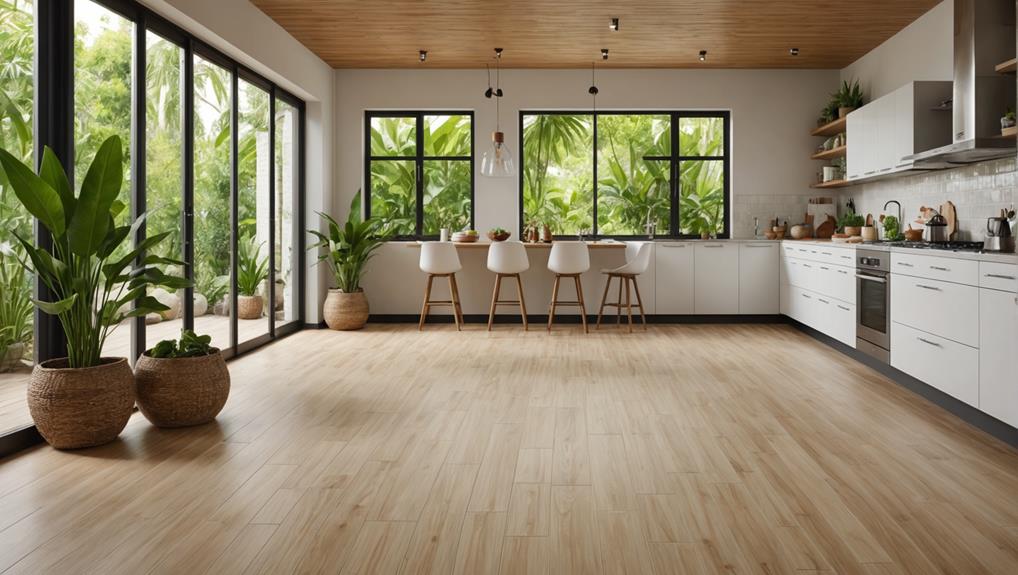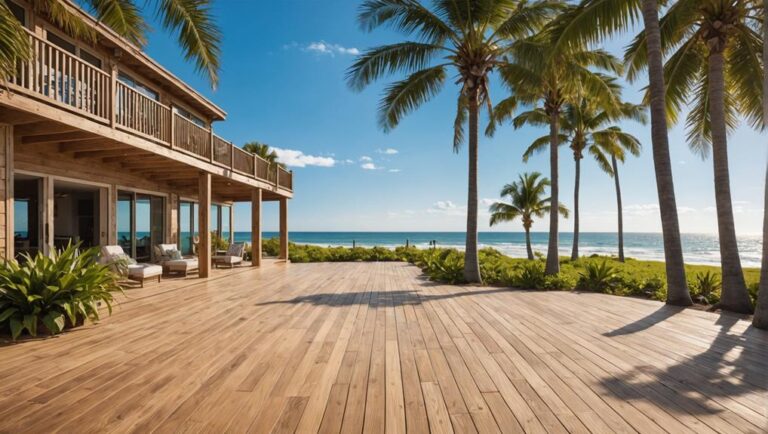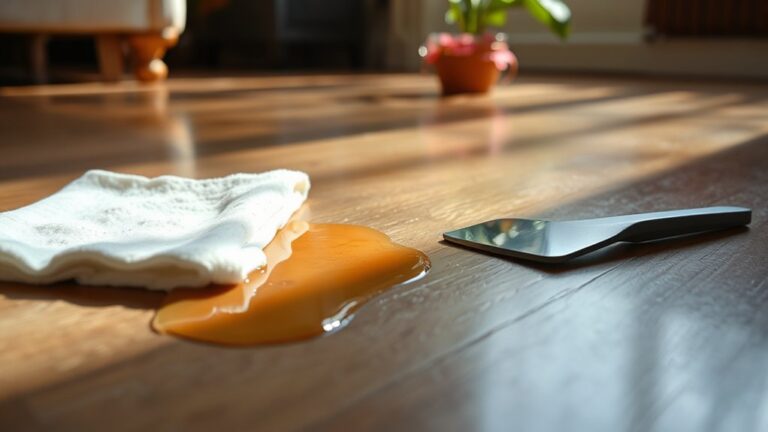If you're living in a humid region, choosing the right flooring can make all the difference. Consider options like engineered hardwood for durability, or luxury vinyl plank, which is waterproof and mold-resistant. Porcelain and ceramic tiles are also excellent, as they resist scratches and moisture. Bamboo and cork offer eco-friendly alternatives, both naturally resistant to humidity. Laminate flooring is designed for moisture, while rubber provides excellent slip resistance. Each type has unique maintenance needs, so your choice impacts long-term health and aesthetics. Explore further, and you'll uncover even more options and tips for resilient flooring solutions.
Engineered Hardwood
When it comes to choosing flooring for humid regions, the durability of engineered hardwood stands out as a practical choice. Unlike traditional hardwood, engineered hardwood is constructed with multiple layers, making it less susceptible to warping and moisture damage. This resilience is vital in environments where humidity can wreak havoc on flooring materials, ensuring that your investment remains intact over time.
One of the key benefits of engineered hardwood is its design versatility. You can find it in a wide range of styles, finishes, and colors, allowing you to create a space that reflects your unique taste. Whether you prefer a rustic oak or a sleek maple finish, engineered hardwood can complement any interior design scheme while maintaining its structural integrity.
Additionally, when considering the environmental impact, engineered hardwood has the upper hand. Since it's made from a thinner veneer of real wood over high-quality plywood, it uses less hardwood than solid flooring. This approach not only conserves valuable resources but also reduces the carbon footprint associated with manufacturing. By choosing engineered hardwood, you're making a safer choice for both your home and the planet.
Ultimately, if you're looking for a flooring option that combines durability, style, and environmental consciousness, engineered hardwood is an excellent choice for humid regions. It offers the peace of mind you need while enhancing the beauty of your living space.
Luxury Vinyl Plank
When you're considering flooring for humid regions, Luxury Vinyl Plank (LVP) stands out for its impressive water resistance properties. It's not just about durability; knowing the right installation and maintenance tips can extend its lifespan and keep it looking great. Let's explore how LVP can be a smart choice for your space.
Water Resistance Properties
Luxury vinyl plank (LVP) flooring excels in water resistance, making it an ideal choice for humid regions where moisture can wreak havoc on traditional flooring materials. With its advanced waterproof coatings and exceptional humidity control, LVP stands out as a reliable option for homeowners seeking durability and safety.
Here are three key water resistance properties of LVP:
- Waterproof Surface: LVP's waterproof coatings prevent moisture penetration, ensuring that spills or humidity won't damage the flooring.
- Mold and Mildew Resistance: The materials used in LVP inhibit mold and mildew growth, which is essential in humid areas where these issues can pose health risks.
- Stability in Humid Conditions: Unlike wood or laminate, LVP maintains its shape and integrity even in high humidity, preventing warping and buckling.
Choosing luxury vinyl plank means prioritizing a safe environment for you and your family. Its combination of waterproof features and resilience makes it a smart investment for those living in areas prone to excessive moisture. You can enjoy peace of mind knowing your flooring can handle the challenges posed by humidity without compromising safety or aesthetics.
Installation and Maintenance Tips
Although selecting the right flooring is vital, proper installation and maintenance are equally important to maximize the benefits of luxury vinyl plank (LVP). Start with reliable installation techniques to guarantee durability in humid environments. Make certain the subfloor is clean, dry, and level to prevent moisture issues. Use a recommended underlayment to enhance comfort and sound insulation. Follow the manufacturer's guidelines for laying down planks, allowing for expansion gaps around the perimeter of the room to accommodate humidity changes.
After installation, establishing effective maintenance routines is essential. Regularly sweep or vacuum the 床 to remove dirt and debris, which can scratch the surface. For deeper cleaning, use a damp mop with a gentle cleaner specifically designed for LVP. Avoid harsh chemicals that could damage the finish. Additionally, consider placing mats at entry points to reduce moisture from outside.
Lastly, keep an eye on humidity levels in your home. Using a dehumidifier can help maintain a stable environment, guaranteeing your LVP remains in peak condition. By adhering to these installation and maintenance tips, you'll enjoy a beautiful and long-lasting floor that withstands the challenges of humid regions.
Porcelain and Ceramic Tile
When it comes to flooring in humid regions, porcelain and ceramic tile stand out for their impressive moisture resistance properties. You'll find that these tiles not only repel water but also offer durability that can withstand the test of time. To keep them looking pristine, it's crucial to follow some maintenance and care tips that will enhance their longevity and performance.
Moisture Resistance Properties
How do you choose the right flooring for humid regions? When dealing with high humidity, you need flooring that can withstand moisture without compromising durability. Porcelain and ceramic tiles excel in this area, offering robust moisture resistance that minimizes the humidity effects on your living space.
Here are three key benefits of choosing porcelain or ceramic tiles:
- Low Porosity: Both materials possess low porosity, making them less likely to absorb water, which helps prevent mold and mildew growth.
- Durable Surface: Their hard, glazed surfaces resist scratches and stains, ensuring that your floors maintain their aesthetic appeal and structural integrity over time.
- Easy to Clean: With minimal upkeep required, these tiles can be easily wiped down, making them ideal for homes in humid climates where spills and moisture are common.
メンテナンスとケアのヒント
Even with their impressive moisture resistance, porcelain and ceramic tiles require regular maintenance to keep them looking their best in humid environments. To start, use gentle cleaning techniques like a soft mop and a pH-neutral cleaner. Avoid harsh chemicals that can damage the tile's surface or grout. Regularly sweeping or vacuuming is essential to remove dirt and debris that can lead to scratches.
Humidity control is vital in preventing mold and mildew. Consider using a dehumidifier in particularly damp areas, which can help maintain ideal moisture levels. If you notice any staining or buildup, tackle it promptly with a suitable tile cleaner to prevent long-term damage.
Inspect your grout regularly, as it can absorb moisture and become discolored. Sealing the grout every few years will enhance its resistance to moisture and stains. Additionally, always dry spills immediately to prevent them from seeping into the grout.
竹フローリング
Bamboo flooring stands out as a sustainable and stylish choice for humid regions, offering both aesthetic appeal and resilience. When you're looking for flooring that can withstand moisture, bamboo's natural properties make it a top contender. Not only does it enhance your space with its unique bamboo aesthetics, but it also promotes bamboo sustainability by utilizing a material that grows rapidly and requires less energy to harvest compared to traditional hardwoods.
Here are three key benefits of choosing bamboo flooring for humid areas:
- 耐湿性: Bamboo has a natural resistance to water, making it less prone to warping or swelling compared to conventional wood flooring. This feature is essential in humid climates, where excess moisture can lead to structural issues.
- 耐久性: Engineered bamboo flooring is crafted to withstand heavy foot traffic and daily wear. Its hardness ensures long-lasting beauty and functionality, providing peace of mind for you and your family.
- 環境に優しい: Choosing bamboo contributes to a more sustainable environment. As a rapidly renewable resource, bamboo can be harvested every 3-5 years without harming the plant, promoting a healthier ecosystem.
ラミネートフローリング
When it comes to flooring options for humid regions, laminate flooring offers a practical and versatile solution. This type of flooring is engineered to resist moisture, making it an excellent choice for areas prone to humidity. You'll appreciate its durability, as it can withstand the wear and tear of daily life while still providing a beautiful aesthetic appeal.
One of the biggest advantages of laminate flooring is its cost comparison to other flooring types. It typically costs less than hardwood and even some tiles, without compromising style. Plus, you can find an array of designs that mimic natural wood or stone, giving you plenty of options to match your decor.
Here's a quick look at some key factors to evaluate:
| 要素 | 詳細 |
|---|---|
| 耐湿性 | High; designed for humid climates |
| Installation Cost | Generally lower than hardwood |
| メンテナンス | 掃除やメンテナンスが簡単 |
ゴム製床材
Rubber flooring is an innovative choice for humid regions, combining practicality with comfort. If you're considering flooring options that can withstand moisture while providing safety and ease of maintenance, rubber flooring might just be the solution you're looking for. Here's a closer look at some of the fantastic rubber flooring benefits:
- 耐水性: Rubber flooring is naturally resistant to water and moisture, making it ideal for areas prone to humidity. You won't have to worry about warping or mold, which can be a major concern with other materials.
- 滑り止め: Safety is essential, especially in wet conditions. Rubber flooring features a textured surface that enhances grip, reducing the risk of slips and falls. This is particularly beneficial in homes with children or elderly residents.
- 簡単なインストール: When it comes to rubber flooring installation, you'll find it's straightforward. Many products come in interlocking tiles or sheets, allowing for a DIY approach, or you can hire a professional for a seamless finish.
With its unique combination of durability and comfort, rubber flooring stands out as a top contender for humid environments. You'll appreciate its resilience, safety features, and low-maintenance characteristics that make it a smart investment for your home. Don't overlook the tremendous potential of rubber to enhance your living space while keeping it safe and stylish!
コルクフローリング
If you're looking for an alternative that offers both warmth and moisture resistance, cork flooring might catch your interest. This eco-friendly option is derived from the bark of cork oak trees, making it a sustainable choice for your home. One of the standout cork flooring benefits is its natural resistance to mold and mildew, essential for humid regions where moisture often becomes a problem. This characteristic not only keeps your floors safe but also maintains a healthy indoor environment.
Cork flooring also provides excellent insulation properties, keeping your space warm in the winter and cool during the summer. You'll appreciate how it feels underfoot, offering a cushioned surface that reduces strain on your joints—ideal for homes with children or elderly residents.
When it comes to cork flooring aesthetics, you'll find a variety of styles and colors to suit your design preferences. From classic natural tones to vibrant stained options, cork can complement any decor. Its unique texture adds warmth and character, enhancing the overall ambiance of your space.
Additionally, cork is not only comfortable but also durable. With proper maintenance, it can withstand the rigors of daily life, making it a practical choice for high-traffic areas. To sum up, cork flooring combines beauty with functionality, ensuring you have a safe, stylish, and moisture-resistant flooring option for your home in humid regions.
よくある質問
How Does Humidity Affect Floor Maintenance Routines?
Did you know that high humidity can increase mold growth by up to 30%? When you're maintaining your floors, humidity's impact is vital. You'll likely need to adjust your maintenance frequency; more humid environments require regular cleaning and inspections to prevent damage. Keeping floors dry and well-ventilated is fundamental for safety. By adapting your routine, you can guarantee your floors remain in good condition and minimize health risks associated with excess moisture.
Can I Use Rugs With Humidity-Resistant Flooring?
Absolutely, you can use rugs with humidity-resistant flooring! Just make certain you choose rug materials that can handle moisture, like synthetic fibers or natural options such as wool. These materials resist humidity effects better than others. Be mindful, though, as dampness can lead to mold or mildew. Regularly check underneath your rugs to keep your space safe and healthy, making sure both style and functionality in your humid environment. It's all about balance!
What Are the Best Cleaning Products for Humid Regions?
"An ounce of prevention is worth a pound of cure." When it comes to cleaning in humid regions, you'll want to use mold and mildew-resistant products. Look for eco-friendly options that contain anti-bacterial agents. Vinegar and baking soda are great natural cleaners, or consider store-bought solutions specifically designed for humid climates. Always follow safety guidelines and ventilate your area well. Remember, consistent cleaning can prevent bigger problems down the road!
Are There Specific Installation Techniques for Humid Environments?
When you're installing flooring in humid environments, specific techniques are essential. You'll want to make certain a proper moisture barrier is in place to protect against dampness. Start with thorough subfloor preparation—make sure it's clean and dry. Using appropriate adhesives and allowing for expansion gaps is important too. This way, you'll minimize the risk of warping or mold, keeping your space safe and durable. Don't skimp on these steps for long-lasting results!
How Do I Prevent Mold Growth Under Flooring?
How can you keep your flooring free from mold? To prevent mold growth under your flooring, consider using mold-resistant flooring materials. Guarantee proper ventilation in your space to reduce humidity levels. Installing a vapor barrier can also help keep moisture out. Regularly inspect and clean under your flooring, addressing any leaks immediately. By prioritizing mold prevention, you'll create a safer, healthier environment in your home. Don't compromise on safety—act now!




